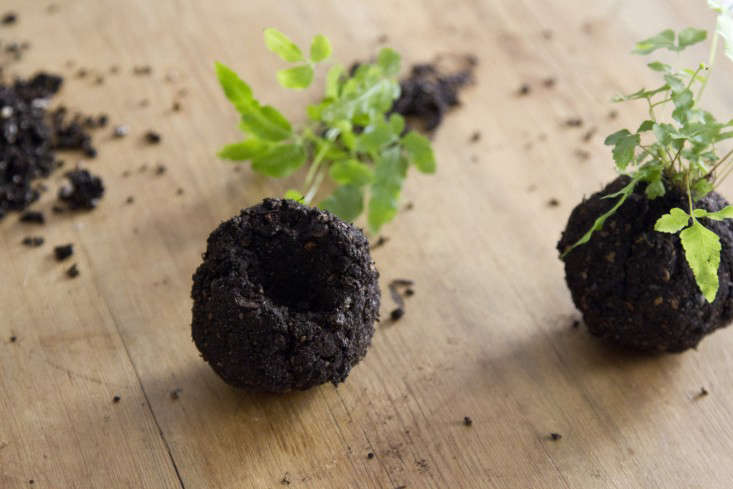Kokedamas from Japan use moss to retain moisture and don’t require planters or pots. Everyone loves a self-sufficient houseplant.
In the tradition of Japanese kokedama–which uses moss to retain moisture instead of a pot–here are instructions for making a planter-less houseplant of your own.
Photography by Erin Boyle.

Above: A tiny fern kokedama lives on my dresser. Here’s how I made it:

Above: Soils, moss, tiny plants, and waxed string are the basic materials you need to make a DIY kokedama.
Materials
- Peat Moss; a 10-quart bag is $12.64 at Amazon
- Bonsai Soil (or akedama); $15.95 on Amazon
- Sphagnum Moss; $3.59 at Ace Hardware
- Miniature ferns or other low-light plants (The Five-Plant Terrarium Bundle, with roots freed from excess soil is $17.99 from Josh’s Frogs)
- Waxed string (Maine Thread has Waxed String in a variety of weights and colors starting at $4.40.)
- Water
- Mixing bowl

Above: To keep a kokedama healthy and happy, sphagnum moss, bonsai soil, and peat moss are the magic three ingredients you need to retain water.

Above: Begin by mixing soil in a 7:3 ratio of peat moss to akedama, or bonsai soil. After mixing, wet the soil until it’s moist enough to form a ball without falling apart.
Tip: Peat moss should be available at most hardware stores, but the more-difficult-to-find bonsai soil is best found online or at specialty bonsai stores.

Above: Use your hands to form round balls. I wanted to make small planters, so I made balls of soil that were about 3 inches in diameter.

Above: After forming the soil balls, use your fingers to make a small hole in the balls. Don’t panic if a ball cracks a bit as you bore the hole; you can pat it back together afterward.

Above: To prepare the plant, remove as much excess soil from the roots as possible.

Above: Next, tuck the plant’s roots into the hole. If the soil ball crumbles, mold it back into shape.

Above: To hold in moisture, you’ll need to wrap the soil ball in moss. You can use either sphagnum moss or sheet moss. Sheet moss will create a greener moss ball, while sphagnum is more golden.
Tip: Sphagnum moss usually comes dry and needs to be reconstituted with water–follow the seller’s instructions.

Above: Holding the moss-covered soil ball in one hand, use your other hand to wrap the ball in twine. I used a random criss-cross pattern to hold the moss in place. You can use any twine you like; I found that sticky waxed twine held everything together easily.

Above: After wrapping, secure the twine with a knot.

Above: If you decide to hang the kokedama, tie two lengths of twine on opposite sides of the moss ball and suspend from a hook.

Above: A 6-inch Iron Hook from Brook Farm General Store is a simple option for hanging a small kokedama; $9. Depending on the wall, you might want to use a drywall anchor. A package of 50 Self-Drilling Dry Wall Anchors from Lowe’s is $13.48.

Above: If you don’t have a spot to hang a planter, rest it in a small ceramic bowl or dish instead.
To care for a kokedama, give it diffused sunlight and water once a week (dunk it in a bowl of water and allow it to drip dry over a sink or saucer).
The perfect ceramic dish? See All The Freshness of New York: Katakana Ceramics on Remodelista. Looking for low-maintenance houseplants? See Expert Advice: 10 Best Low-Maintanence Houseplants.















Have a Question or Comment About This Post?
Join the conversation